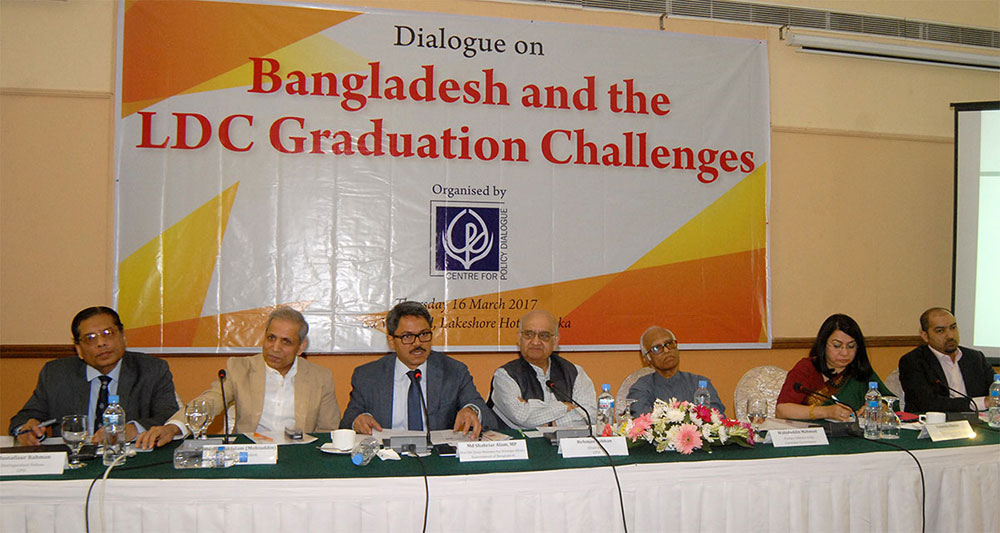Ensuring Smooth Transition: Govt's Focus On LDC Graduation

Table of Contents
Economic Diversification Strategies for LDC Graduation
Economic diversification is paramount for sustainable LDC graduation. A reliance on a single sector leaves countries vulnerable to external shocks. Diversification requires a multi-pronged approach focusing on several key areas:
Promoting Sustainable Industrial Growth
Sustainable industrial growth is the engine of economic transformation. This involves shifting from low-value to high-value added manufacturing, attracting foreign direct investment (FDI), and developing robust export capabilities beyond traditional commodities. Key strategies include:
- Implementing supportive industrial policies: These policies should focus on reducing bureaucratic hurdles, providing tax incentives, and creating special economic zones to attract investment. Targeted support for specific industries with high growth potential is crucial.
- Investing in infrastructure development: Adequate infrastructure, including roads, energy, and information and communication technology (ICT), is essential for attracting investment and facilitating trade. Reliable and affordable energy is particularly critical for industrial growth.
- Providing training and skills development programs: A skilled workforce is essential for competing in global markets. Investment in education and training programs tailored to the needs of emerging industries is vital for successful LDC graduation.
- Facilitating access to finance for small and medium-sized enterprises (SMEs): SMEs are the backbone of many economies. Access to credit and financial services is crucial for their growth and contribution to economic diversification. Microfinance initiatives and government-backed loan programs can play a vital role.
Boosting Agricultural Productivity and Resilience
Agriculture remains a significant sector in many LDCs. Boosting agricultural productivity and building resilience to climate change are essential for ensuring food security and generating income. Strategies include:
- Investing in agricultural research and development: Research into drought-resistant crops, improved farming techniques, and efficient irrigation systems is crucial for increasing yields and adapting to climate change.
- Promoting sustainable agricultural practices: Sustainable farming methods, such as conservation agriculture, can enhance soil fertility, reduce water consumption, and protect biodiversity.
- Improving access to credit and insurance for farmers: Access to affordable credit and crop insurance can help farmers manage risks and invest in improved farming practices.
- Developing robust market linkages and value chains: Efficient market access and the development of value chains can help farmers get better prices for their produce and increase their income.
Developing a Robust Tourism Sector
Tourism can be a significant source of revenue and employment in LDCs, particularly those with rich natural or cultural heritage. Developing a sustainable tourism sector requires careful planning and investment:
- Investing in tourism infrastructure: This includes developing transportation networks, accommodations, and other facilities that support tourism activities. This can attract a larger number of tourists and increase overall revenue.
- Developing sustainable tourism management practices: Sustainable practices ensure that tourism benefits local communities while protecting the environment and cultural heritage. This creates a long-term sustainable industry.
- Marketing the country’s tourism potential effectively: Targeted marketing campaigns can attract tourists and increase visitor numbers. Focusing on unique aspects of the culture and nature will help attract a wider audience.
- Training local communities in hospitality and tourism-related skills: Providing training in hospitality, guiding, and other tourism-related skills empowers local communities to participate in and benefit from the tourism industry.
Strengthening Institutional Capacity for LDC Graduation
Strong institutions are the foundation of good governance and sustainable development. Building institutional capacity is crucial for successful LDC graduation.
Good Governance and Transparency
Good governance and transparency are essential for attracting investment and building trust. Strategies include:
- Strengthening the rule of law and improving judicial systems: An independent and efficient judiciary is crucial for protecting property rights and enforcing contracts.
- Promoting good governance and transparency in public administration: Transparent and accountable government institutions are essential for building public trust and attracting investment.
- Enhancing citizen participation in decision-making processes: Citizen involvement in decision-making processes ensures that policies are responsive to the needs of the people.
- Fighting corruption effectively: Corruption undermines development efforts and discourages investment. Strong anti-corruption measures are essential for building a just society.
Improving Human Capital Development
Investing in human capital—education, health, and skills development—is crucial for building a productive workforce. Strategies include:
- Improving access to quality education at all levels: Access to quality education is essential for equipping individuals with the skills and knowledge needed to participate in the economy.
- Strengthening healthcare systems and promoting public health initiatives: A healthy population is a productive population. Investing in healthcare systems is crucial for improving the overall health and well-being of the population.
- Providing vocational training and skills development opportunities: Providing vocational training and skills development opportunities ensures that people have the skills needed for the jobs of the future.
- Enhancing digital literacy and access to technology: Digital literacy is increasingly important in today's world. Ensuring access to technology and digital literacy training is crucial for economic participation.
Building Resilient Infrastructure
Investing in resilient infrastructure is crucial for withstanding climate change and other shocks. Strategies include:
- Developing climate-resilient infrastructure: Infrastructure must be designed and built to withstand the impacts of climate change, such as floods, droughts, and extreme weather events.
- Improving disaster preparedness and response mechanisms: Effective disaster preparedness and response mechanisms are essential for minimizing the impact of natural disasters.
- Investing in renewable energy sources: Investing in renewable energy sources reduces reliance on fossil fuels and mitigates the impacts of climate change.
- Strengthening early warning systems: Early warning systems for natural disasters are crucial for protecting lives and property.
Securing International Support for LDC Graduation
International support is crucial for successful LDC graduation. Securing development finance and building strong partnerships are vital.
Accessing Development Finance
Accessing concessional loans, grants, and technical assistance from international development partners is crucial for financing development programs. Strategies include:
- Engaging with international financial institutions (IFIs): Working with IFIs such as the World Bank and the International Monetary Fund can provide access to concessional loans and technical assistance.
- Mobilizing private sector investment: Attracting private sector investment is crucial for financing large-scale infrastructure projects and other development initiatives.
- Accessing grant funding from bilateral and multilateral donors: Grant funding from bilateral and multilateral donors can provide crucial resources for development programs.
- Negotiating favorable trade agreements: Negotiating favorable trade agreements can improve market access and boost export earnings.
Building Strong Partnerships
Building strong partnerships with other LDCs and developed countries is essential for sharing best practices and experiences. Strategies include:
- Participating in international forums and conferences: Participating in international forums and conferences allows countries to share experiences and learn from others.
- Sharing knowledge and expertise with other countries: Sharing knowledge and expertise with other countries can accelerate development progress.
- Engaging with civil society organizations and the private sector: Engaging with civil society organizations and the private sector can leverage their expertise and resources for development efforts.
- Building South-South cooperation partnerships: South-South cooperation partnerships can help countries learn from each other's experiences.
Conclusion
Successful LDC graduation requires a comprehensive strategy encompassing economic diversification, strengthened institutional capacity, and securing international support. The government's proactive approach in these areas is vital for achieving a smooth transition and ensuring sustainable development. By continuing to invest in these key pillars, countries can pave the way for long-term prosperity and improve the lives of their citizens. Let's work together to support and further the progress of LDC graduation initiatives. The continued focus on LDC graduation strategies is vital for a brighter future.

Featured Posts
-
 Learn From Buffett Avoiding Errors And Cultivating Humility In Leadership
May 07, 2025
Learn From Buffett Avoiding Errors And Cultivating Humility In Leadership
May 07, 2025 -
 Papezev Blagoslov Urbi Et Orbi Francisek Pozdravi Mnozico Na Trgu Sv Petra
May 07, 2025
Papezev Blagoslov Urbi Et Orbi Francisek Pozdravi Mnozico Na Trgu Sv Petra
May 07, 2025 -
 Trumps Crypto Holdings From Denial To Reported Massive Returns
May 07, 2025
Trumps Crypto Holdings From Denial To Reported Massive Returns
May 07, 2025 -
 Apple Watches On Ice How Nhl Referees Use Smart Technology
May 07, 2025
Apple Watches On Ice How Nhl Referees Use Smart Technology
May 07, 2025 -
 Greg Abel From Canadian Roots To Berkshire Hathaways Top Spot
May 07, 2025
Greg Abel From Canadian Roots To Berkshire Hathaways Top Spot
May 07, 2025
